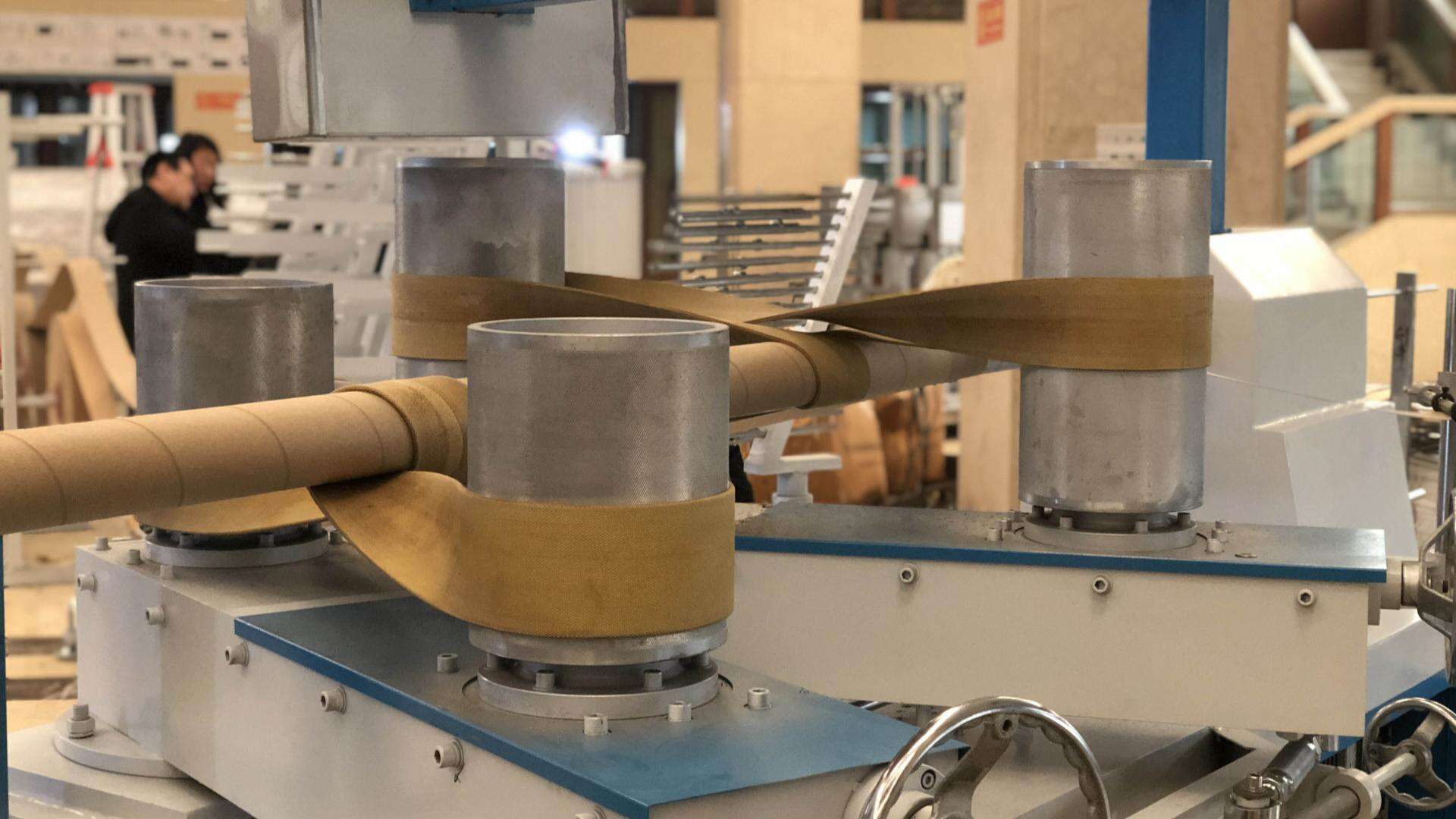How Tube Winder Belts Function in Spiral-Winding Machines
In spiral winding operations, tube winder belts act as the main power transfer element, pressing paper or plastic materials against spinning mandrels with carefully controlled radial force. Most quality belts maintain a friction range somewhere between 0.35 to 0.45 according to recent studies from Tribology International. This helps keep things running smoothly without slipping when making those helical windings. What makes these endless belts really valuable is how they work hand in hand with the spindle drive system. When everything stays in sync, it creates that precise overlap needed for consistently thick walls throughout industrial packaging tubes. Getting this right matters a lot because uneven thickness can lead to all sorts of problems down the production line.
Belt Compatibility and Its Impact on Paper Core Consistency
When the materials used in tube winder belts match well with the paper being processed, it actually cuts down on core ellipticity problems by around 12 percent compared to when they don't match up properly (as noted in the Journal of Adhesion Science back in 2022). The belts with those tiny surface textures that work with how adhesives flow can stop glue starvation issues from happening while running at top speeds. Factory floor reports show that companies switching to belts reinforced with polyamide experience roughly 15-20% less variation in core density compared to old school rubber belts. This matters because consistent cores mean better product quality and fewer rejects coming off the production line.
The Relationship Between Belt Tension Control and Dimensional Accuracy
The servo controlled tensioners found in today's tube winding equipment keep belt stress levels around ±2.5 N per square millimeter, which helps achieve finished tube diameters that stay within about ±0.15 mm tolerance. When belts aren't properly tensioned, they tend to shift radially by more than 0.3 mm. On the flip side, if the tension gets too high, belt fatigue goes up roughly 40 percent according to a study from Packaging Technology Review last year. These systems have closed loop monitoring that catches force changes and makes corrections within just 50 milliseconds. This kind of fast response time is what keeps those dimensional specs consistent across production runs.
Balancing High-Speed Operation With Belt Durability
Modern tube winder belts can handle around 800 meters per minute during operation and typically last about 2.3 million winding cycles before needing replacement. That's roughly 70% better than what was available back in 2018 according to the Industrial Belt Consortium Report from 2023. When it comes to advanced polyurethane belts containing those special aramid fibers, they show really impressive results too. These belts only wear down at about 0.08 millimeters per hour even when running faster than 700 m/min. What does this mean practically? Well, maintenance needs get cut nearly in half compared to older models, which saves both time and money for manufacturers dealing with high volume production lines.
Custom Tube Winder Belt Solutions for Specialized Applications
Designing Belts for Variable-Diameter Paper Cores
Modern tube winder belts equipped with adaptive tensioning can handle core sizes ranging anywhere from just 12mm up to massive 300mm diameters. What this means for manufacturers is they don't have to swap out belts when switching between cosmetic products and heavier industrial tubes. According to recent data from Packaging Machinery Report (2023), these adaptable systems actually reduce changeover times by around 19% compared to older fixed-tension models. The secret lies in special urethane materials that maintain grip regardless of diameter size. These advanced compounds create reliable friction surfaces throughout the entire range, so there's no risk of slippage even during those intense high-torque winding processes that tend to push equipment to its limits.
Matching Belt Surface Texture to Adhesive Requirements in Laminated Tubes
Manufacturers now offer six standardized surface textures tailored to specific adhesives:
| Adhesive Type | Ideal Belt Texture | Bond Strength Improvement |
|---|---|---|
| Hot Melt | Micro-grooved | 22% |
| PVA | Diamond-embossed | 17% |
| Epoxy | Smooth finish | 31% |
Textured surfaces enhance mechanical bonding for fast-setting adhesives, while smooth finishes allow clean release from slow-cure resins. A 2023 study showed a 40% reduction in delamination defects when using texture-matched belts.
Case Study: 18% Scrap Reduction in Corrugated Packaging Plant With Tailored Belts
A packaging plant in North America saved around $217k each year after switching to variable durometer belts on their winding lines. The belt design had 85A hardness urethane which stands up well to wear and tear, plus 70A backing layers that absorb shocks during operation. They also included those neat little laser engraved markers for proper alignment. These changes made all the difference when it comes to core deformation problems that happen especially bad in humid environments. Over about fourteen months, they saw scrap rates drop from nearly 9.2% down to just 7.5%. And maintenance expenses went down by almost a quarter too because these belts come with built in wear indicators that actually tell operators when replacements are needed with pretty good accuracy - within about five percent either way.
Optimizing Efficiency and Reducing Downtime with Smart Belt Management
How optimized tube winder belts improve manufacturing efficiency
Precision-engineered tube winder belts reduce slippage and uneven winding forces, cutting paper core defects by 18% compared to standard belts (PPSA 2023). By maintaining uniform contact pressure on adhesive-coated mandrels, they eliminate post-production trimming in 73% of rigid tube applications.
Predictive maintenance: Cutting line stoppages by 30%
Real-time tension monitoring enables predictive maintenance systems to forecast belt failures 12–72 hours in advance. According to a 2024 Industrial Materials Report, facilities using AI-driven models reduced unplanned shutdowns from belt issues by 31% and extended service intervals by 40%.
Integrating smart sensors for real-time belt performance monitoring
Embedded IoT sensors track six key parameters:
- Dynamic tension variance (±2% accuracy)
- Micro-vibration patterns (0–500 Hz range)
- Surface temperature differentials
- Edge wear progression
- Chemical exposure levels
- Torque distribution
This data allows real-time adjustments to winding parameters without halting production.
The rise of self-tracking industrial belting components
Next-generation belts with embedded RFID chips automatically log critical metrics:
| Metric | Tracking Frequency | Alert Threshold |
|---|---|---|
| Elongation | Every 50 cycles | >2% beyond spec |
| Surface abrasion | Real-time | 0.2mm depth change |
| Ply separation risk | Hourly | 85% adhesive integrity |
Preventing unplanned downtime: Identifying micro-cracking and belt fatigue
Hyperspectral imaging detects subsurface defects as small as 50μm during operation. Early identification of micro-cracks enables planned replacements during scheduled maintenance, preserving 92% of production uptime compared to emergency interventions.
Extending belt life through strategic rotation and monitoring
A three-stage rotation protocol increases belt lifespan by 210%:
-
Primary Position
High-stress mandrel contact zone (0–200 hours) -
Secondary Position
Moderate edge-wear area (201–400 hours) -
Tertiary Position
Low-impact guide path (401–600 hours)
Operators using this method achieve an average of 5.7 rotations before end-of-life, far exceeding the industry standard of 2.1 rotations.
FAQ
What role do tube winder belts play in spiral-winding machines?
Tube winder belts facilitate the main power transfer by applying controlled radial force to press materials against spinning mandrels, ensuring precise overlap and consistency in tube wall thickness.
How does belt compatibility affect paper core consistency?
Compatible materials in tube winder belts reduce core ellipticity problems and prevent glue starvation, leading to better product quality and fewer rejects.
What impact does belt tension have on dimensional accuracy?
Proper belt tension, maintained by servo-controlled tensioners, is crucial for achieving dimensional accuracy, preventing radial shifts, and reducing belt fatigue.
How can high-speed operation and belt durability be balanced?
Modern belts, particularly advanced polyurethane ones, last longer and are more durable, requiring less maintenance and supporting higher-speed operations.
What innovations are present in modern high-performance tube winder belts?
Innovations include the use of hybrid elastomers, composite materials, thermal resistance, and enhanced tensile strength, which improve performance and longevity.
What advantages do custom tube winder belt solutions offer?
Custom solutions optimize efficiency by matching belt properties to specific applications, improving changeover times and reducing defects and maintenance needs.
Table of Contents
- How Tube Winder Belts Function in Spiral-Winding Machines
- Belt Compatibility and Its Impact on Paper Core Consistency
- The Relationship Between Belt Tension Control and Dimensional Accuracy
- Balancing High-Speed Operation With Belt Durability
- Custom Tube Winder Belt Solutions for Specialized Applications
- Designing Belts for Variable-Diameter Paper Cores
- Matching Belt Surface Texture to Adhesive Requirements in Laminated Tubes
- Case Study: 18% Scrap Reduction in Corrugated Packaging Plant With Tailored Belts
-
Optimizing Efficiency and Reducing Downtime with Smart Belt Management
- How optimized tube winder belts improve manufacturing efficiency
- Predictive maintenance: Cutting line stoppages by 30%
- Integrating smart sensors for real-time belt performance monitoring
- The rise of self-tracking industrial belting components
- Preventing unplanned downtime: Identifying micro-cracking and belt fatigue
- Extending belt life through strategic rotation and monitoring
- FAQ

 EN
EN
 AR
AR
 HR
HR
 DA
DA
 NL
NL
 FR
FR
 DE
DE
 EL
EL
 HI
HI
 IT
IT
 JA
JA
 KO
KO
 NO
NO
 PL
PL
 PT
PT
 RO
RO
 RU
RU
 ES
ES
 TL
TL
 IW
IW
 ID
ID
 SR
SR
 SK
SK
 UK
UK
 VI
VI
 TH
TH
 TR
TR
 AF
AF
 MS
MS
 IS
IS
 HY
HY
 AZ
AZ
 KA
KA
 BN
BN
 LA
LA
 MR
MR
 MY
MY
 KK
KK
 UZ
UZ
 KY
KY
